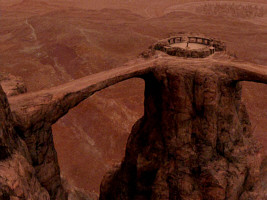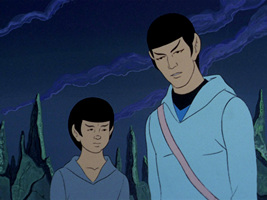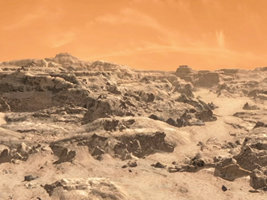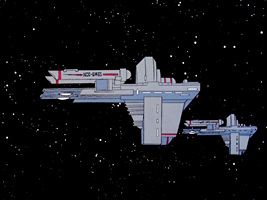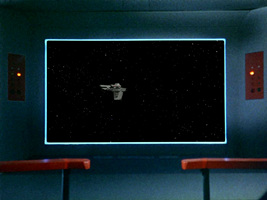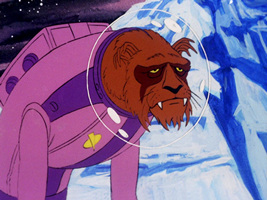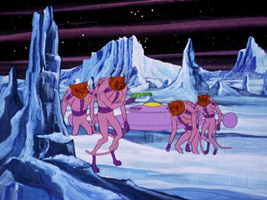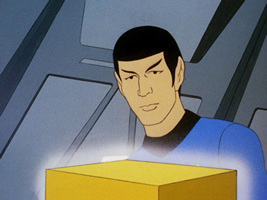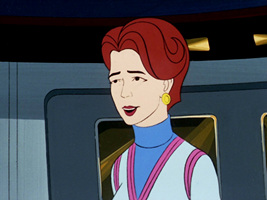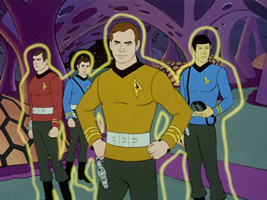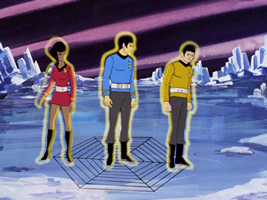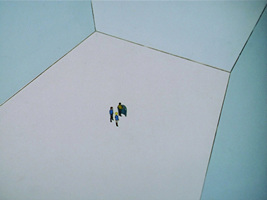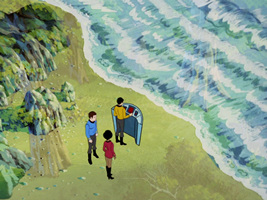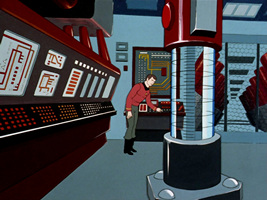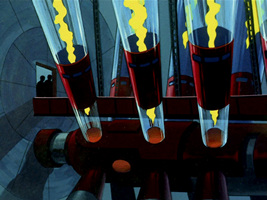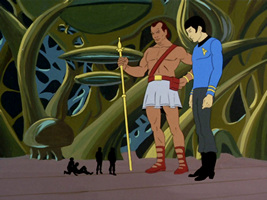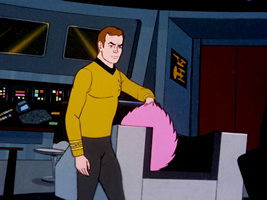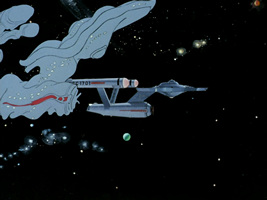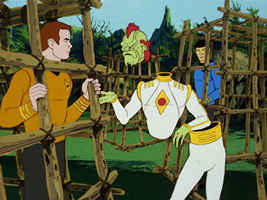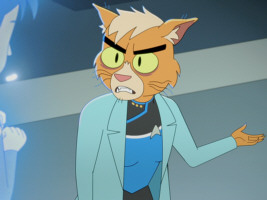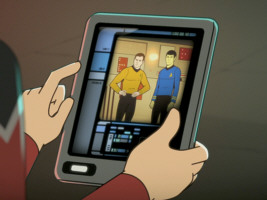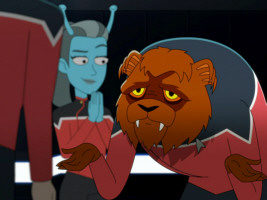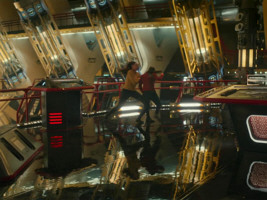The Problems of Canonizing TAS
Continuity IssuesQuality and Compatibility ConcernsConclusionCommentaryRecent Developments
 Gene Roddenberry purportedly ruled that The Animated Series (TAS), produced in 1973/73, shouldn't be canon. All official sources since the beginning of TNG in 1987 used to heed this tenet. Aside from single isolated factoids the events from TAS were usually not referenced in live-action Trek and were not incorporated in any official reference works. However, in the course of the DVD release of 2006 Paramount seems to have decided that the two seasons of the series should be regarded as canon in the future. Even though this prompt decision is debatable, it may necessitate the fans, who so far have been following the former canon policy, to thoroughly reconsider the status of TAS.
Gene Roddenberry purportedly ruled that The Animated Series (TAS), produced in 1973/73, shouldn't be canon. All official sources since the beginning of TNG in 1987 used to heed this tenet. Aside from single isolated factoids the events from TAS were usually not referenced in live-action Trek and were not incorporated in any official reference works. However, in the course of the DVD release of 2006 Paramount seems to have decided that the two seasons of the series should be regarded as canon in the future. Even though this prompt decision is debatable, it may necessitate the fans, who so far have been following the former canon policy, to thoroughly reconsider the status of TAS.
This article discusses if and how compatible TAS is with canon live-action Star Trek.
Continuity Issues
This section sums up some obstacles if we try to reconcile events from TAS, regardless of its animated nature, with the rest of Star Trek. While it has close connections to TOS, TAS has remained largely isolated from the four recent live-action series and the ten movies. Only few tie-ins exist, most of them from TAS: "Yesteryear" that purportedly had a canon status prior to the rest of the series:
 Spock's hometown of ShirKahr or Shi'Kahr (TAS: "Yesteryear") reappears as the name of a Miranda-class ship in the Dominion War and is mentioned in ENT: "Fusion" (ShirKahr Academy). Moreover, we can see the city in the background in the remastered episode TOS-R: "Amok Time".
Spock's hometown of ShirKahr or Shi'Kahr (TAS: "Yesteryear") reappears as the name of a Miranda-class ship in the Dominion War and is mentioned in ENT: "Fusion" (ShirKahr Academy). Moreover, we can see the city in the background in the remastered episode TOS-R: "Amok Time".
- Vulcan's Forge (TAS: "Yesteryear") is referenced in DS9: "Change of Heart" and is extensively featured in the Vulcan trilogy ENT: "The Forge", "The Awakening", "Kir'Shara".
- The kahs-wan ritual (TAS: "Yesteryear") gets a mention in ENT: "Catwalk".
- A Vulcan sehlat, first mentioned in TOS: "Journey to Babel", could be seen in TAS: "Yesteryear". The CG sehlat in ENT: "The Forge" is reminiscent of the animated version.
 The design of the newly created USS Antares in TOS-R: "Charlie X" and of the freighter Woden in TOS-R: "The Ultimate Computer" is much the same as the robot cargo ships from TAS: "More Tribbles, More Troubles".
The design of the newly created USS Antares in TOS-R: "Charlie X" and of the freighter Woden in TOS-R: "The Ultimate Computer" is much the same as the robot cargo ships from TAS: "More Tribbles, More Troubles".
- The Klothos, the ship Kor commanded in TAS: "The Time Trap", is referred to in DS9: "Once More Unto the Breach", albeit the first was a D7 whereas Kor expressly says the latter was a D5.
- Kirk's middle name was always supposed to be Tiberius but consistently abbreviated as "T." in TOS. The name was spoken out as late as in TAS: "Bem" from where it found its way into "Star Trek: The Undiscovered Country".
In contrast, many other facts established in TAS were never referred to again or were even contradicted in later series.
The Enterprise in 2269/70
When the refitted Enterprise is being prepared for launch in "Star Trek: The Motion Picture" (TMP) in 2271, Admiral Kirk says he has been the Chief of Starfleet Operations for two and a half years. Scotty states, "We have spent eighteen months refitting the ship." Since TOS ended in 2268, this would not leave the required one and a half years for the completion of the five-year mission and hence for the events of TAS. Teenage genius Icheb, on the other hand, says in VOY: "Q2" that the end of Kirk's five-year mission was in 2270, thereby supporting the notion of a prolonged mission after the end of TOS. See also Biography Inconsistencies.
The year of TMP of 2271 is not set in stone but is just a result of the assumption that Kirk was promoted just after the end of TOS. The date is referred to only approximately from other series. So if we want TAS to be canon and to take place in 2269/70, then we should trust Icheb's thorough research and move TMP to 2273.
Koloth and Kirk
In TAS: "More Tribbles, More Troubles" the Enterprise encounters Koloth's ship. The two ships exchange fire at the beginning and towards the end of the episode. However, in DS9: "Trials and Tribble-ations" Jadzia Dax claims that Koloth once told Curzon that he regretted never facing Captain Kirk in battle.
This is only a slight inconsistency. Koloth may simply not have considered the two skirmishes as "battles", and he may have preferred to face Kirk in hand-to-hand combat, which didn't happen in the TAS episode.
Lost races
TAS shows us a couple of familiar species from TOS, most obviously Vulcans, Andorians, Tellarites, Klingons, Romulans and Tribbles. But none of the races introduced in TAS is ever heard of again. Most notably the appearances of the species of M'Ress, the feline communications officer, and of the three-legged Arex in TAS are solitary.
The missing links between TAS and modern live-action Trek are not any more troublesome than between Enterprise and TOS. At least the Caitians (tentative name of M'Ress's race that was never canonically mentioned) may have reappeared, albeit uncredited, in "Star Trek IV" where we could spot members of a felinoid race and in "Star Trek V" as the catwoman on Nimbus III. See Galleries - Unidentified Humanoids. Arex's race was named Edoan or Edosian only in backstage materials, but we have Edosian orchids (DS9: "Broken Link"), Edosian slugs (ENT: "Catwalk") and Edosian suckerfish (ENT: "These Are The Voyages") as possible references to them.
The Kzinti
TAS: "The Slaver Weapon" is not a genuine Trek story. Larry Niven based the episode script, along with the concepts of the felinoid Kzinti race and the ancient Slavers, on his Known Space series. Cross-overs naturally tend to be incompatible with either of the involved pieces of fiction and better remain isolated for the sake of continuity and creative integrity. Therefore it is very unlikely that canon Star Trek will ever revisit Known Space (even though Niven may have no objections). Can the existing TAS episode remain canon at all in this light? Moreover, Sulu states in the TAS episode that the last war between Earth and the Kzinti ended 200 years ago. That would have been in 2069, just a couple of years after a devastating war among the nations of Earth, the invention of warp drive and the first contact with an alien species (as established in "Star Trek: First Contact" and on countless other occasions).
Regarding the canonicity of the Kzinti regardless of their history with Earth, certainly only the events depicted or mentioned in TAS: "The Slaver Weapon" can be canon, not anything else from Known Space with its totally diverging timeline. The idea that Earth could have been in a series of wars with the Kzinti any time in the 21st century (that, for some reason, no one but Sulu would remember from history lessons) is so extraordinarily unlikely anyway that we must regard it as a hard continuity error. Without the back story of the Earth-Kzinti wars, on the other hand, the TAS episode makes hardly any sense. The bottom line is that this one episode must be heavily retconned in order to maintain continuity with the rest of Star Trek, and to remain canon at all. It is also very unlikely that the Kzinti, who were not allowed to carry any weapons according to the peace treaty with Earth, wouldn't have been conquered in 200 years. And considering that, in the Known Space series, humanity is not as benevolent as in Star Trek, the cross-over shouldn't have been made in the first place anyway. There are more Kzinti mentions in canon Trek, albeit just in the form of an illegible label on a star map that appeared early TNG, such as notably in "Conspiracy".
Update notice In case the show had not been prematurely canceled, Manny Coto planned a story about the Kzinti in Enterprise's fifth season. It is not clear whether this would have included further references to the Known Space universe or rather only to the TAS episode.
Slaver boxes
These devices from Larry Niven's Known Space that appeared in TAS: "The Slaver Weapon" are not only unusually mystical in their new context of Star Trek. The boxes are also said to play a role in this one episode that they realistically cannot have anywhere else in Star Trek.
Slaver boxes are never shown and not even casually referred to again. But most obviously it is very doubtful that, as Spock says, the Federation could have found the technology for artificial gravity in one of those boxes. Pre-Federation starships of different races commonly already had artificial gravity, so there would be no need for the ancient boxes. And for what it's worth, even Khan's Botany Bay must have had gravity generators as soon as 1992 (or around 2050, depending on the preferred chronology), as seen in TOS: "Space Seed".
Bonaventure - the first warp ship
The Enterprise crew rediscovers the long-missing Bonaventure inside a space anomaly in the Delta Triangle in TAS: "The Time Trap". No date is mentioned as to when the ship was lost. Scotty's statement from the episode that the Bonaventure was "the first ship to have warp drive installed" is inconsistent with several accounts from live-action Star Trek, most notably "First Contact" where we actually saw the first (Earth) ship with warp drive, namely the Phoenix. Pertaining to the Bonaventure's age, Spock adds to Scotty's discovery of the long-lost ship that "the crew's descendants may still be living", thereby implying that at least roughly a century has passed since her disappearance. To add to the confusion, Starfleet veteran Sarah April says she was "the first medical officer aboard a ship equipped with warp drive" in TAS: "The Counter-Clock Incident". On the Bonaventure?
In an attempt to reconcile the Bonaventure with modern Star Trek history and particularly with the already shaky development history of warp propulsion, Scott's line may be re-interpreted in a way that she was more precisely the first starship with a modern warp drive like the Enterprise NCC-1701 has one. Even though Spock insinuates that the Bonaventure must be a century old, the re-interpretation in favor of a somewhat newer ship would work better in consideration of the Bonaventure's look which is not remotely like either the NX-01 or even the Phoenix but undeniably a disfigured version of the Constitution class. Even the markings on the vessel and the uniform patches are almost like in TOS. This is not the fault of the revisionist tendencies of modern Star Trek but posed already a continuity problem at the time the episode was made. At that time the ship must have been intended to be more than 200 years old, so as to predate the unseen Valiant from TOS: "Where No Man Has Gone Before" which must have been a warp vessel. Regarding Sarah April's statement, maybe she simply exaggerated a great deal, considering that the NX-01 already did have warp drive *and* a medical officer. Or does she just mean she was the "first (=chief) medical officer" on no particularly important warp ship, which would pose no problem at all? This doesn't seem so, as she puts too much emphasis on "first", and Kirk agrees with her that she used to be a pioneer in space.
Early transporter technology
In TAS: "The Terratin Incident" the inhabitants of the miniaturized colony purportedly inherited transporter technology from their ancestors. This must have been at least 200 years prior to the episode (2269), owing to the obsolescence of their distress signal. But according to Star Trek Enterprise the technology was not available on any ship prior to 2151.
Either the statement about the age of the signal or about the real origin of the transporter technology may have been inaccurate. We may need to ignore this one-time mishap just like the role of the Bonaventure as the allegedly first warp ship.
Life support belts
We see the landing parties in TAS: "Beyond the Farthest Star" and "The Slaver Weapon" with life support belts that project a forcefield around their bodies that is filled with breathable air. Similarly, in TAS: "The Ambergris Element", Scotty is wearing a forcefield belt instead of a diving suit. He is protected by such a belt in TAS: "Beyond the Farthest Star" too when he is jammed in the Enterprise's massive core hatch. This technology stays completely isolated, as on every occasion before and after TAS only standard-issue spacesuits are used for excursions into open space or hostile atmospheres. Furthermore, at least the Orions are using very similar devices in TAS: "The Pirates of Orion", although there is hardly any contact with the Federation at that time.
Life support belts are not irreconcilable with the live-action series, as they may have been an experimental technology that was being tested on the Enterprise in 2269/70. Still, it would have required an according statement on screen at some time to justify their existence and/or why they eventually failed. Some aliens, most obviously the Borg, will have personal shielding in the 24th century.
Rec Room
In TAS: "The Practical Joker" we see the "Rec Room" with a technology that creates a perfectly realistic simulated environment like the holodeck almost a century later in TNG. What we know is that Commander Riker is astonished about the perfection of the holodeck on the Enterprise-D in "Encounter at Farpoint", and it is implied that something like that is a new accomplishment on Starfleet vessels. Lwaxana Troi doesn't even recognize the purpose of a holodeck when she reads it on the door in "Manhunt". So how can the Enterprise in TAS have a fully functional holodeck with all the capabilities of the TNG version as soon as 2270?
Well, we have something like a holodeck as soon as 2151 on a Xyrillian vessel, so TAS is not alone with this problem. Still, in TAS the technology is already a firmly established part of a Federation starship. A "*recreation* room" is a technology as well as an amenity that would hardly be abandoned soon after the episode and rediscovered almost a century later.
Enterprise engineering
Besides an engine room which is redressed once again since TOS but essentially still the same, the animated Enterprise also has an impressive cathedral-like room (TAS: "One of Our Planets is Missing") with tubes resembling the plasma conduits of later incarnations of Federation ships. Also, there is the big round core hatch that is apparently meant to be the principal access to the actual engine room in TAS (TAS: "Beyond the Farthest Star").
Regarding the spacious room, if it belongs to engineering rather than to a nacelle (the latter of which would cause no trouble), we arguably haven't seen this part of engineering during TOS, although it certainly must have existed. Scotty is speaking of an "antimatter nacelle" in the episode, which sounds like an awkward amalgamation of the two components that should be distinct (there isn't supposed to be antimatter inside the nacelle). Hence, either could be possible. The core hatch could be anywhere near the latter room. We only need to wonder why there is such a massive hatch to seal off the TAS or TOS version of engineering when it can be essentially accessed through normal doors just as well.
Quality and Compatibility Concerns
The nature of The Animated Series is not the same as that of live action due to obvious technical reasons, but also because of the different target audience. TAS won an Emmy Award for the Best Children's Series 1974-75. Yet, regardless of the mere facts established in the series, there are certain qualities or shortcomings that may make TAS incompatible with live-action Star Trek.
Animation quality
TAS is not exactly among the visually best animated series made for TV, although we must concede that the standard was generally lower in the 1970s when in the USA only animations made by Disney and for the big screen would fully exploit the already existing technical possibilities. Ideally an animation should provide a frame rate of 24 true individual images per second, which is necessary to create the impression of smooth natural motion on screen. As a comparably low-budget TV production, however, TAS on average showed only six new drawings per second. TAS customarily used stock sequences, not only for ships in space but also for the characters. Moreover, usually only single body parts of the characters were animated, which makes them often move a bit like robots.
The fidelity of the drawings may have been better as well. For instance, among other inaccuracies the Enterprise seems to have a prolonged engineering hull in TAS which would be very implausible (especially considering that the whole ship will be retrofitted immediately after the end of TAS). In some shots the Enterprise lacks the coloring of details like the Bussard collectors, which should always be reddish, and on these occasions the real ship looks like its inflatable copy in TAS: "The Practical Joker". We need to bear in mind that the Enterprise is still the most carefully drawn starship of the series; alien vessels are usually still less consistent. The Romulan D7 comes in apparently two variants, one being gray (TAS: "The Survivor") and one pale teal (TAS: "The Practical Joker"). But looking closer, we discover that the latter variant is overall sloppily drawn, which makes the existence of two distinct variants of the ship doubtful. Another example of low drawing quality as well as lacking consistency is that there are two variations of Andorians, one of whom may be simply the result of lacking attention to detail.
Voices
I don't contest Jimmy Doohan's talent to imitate voices and dialects. But I think that dissembled voices are not fitting in a TV series that strives to be taken seriously. The dialogues among the principal characters (including Scott, of course) sound like in TOS, with a few concessions to the younger audience and the overall faster pace of the TAS episodes. The alien guests, however, customarily sound like caricatures with their obviously under- or over-pitched voices. Especially since the speakers are mostly the same, with Doohan alone lending his voice to no less than 53 characters! In addition, we can repeatedly hear M'Ress (voiced by Majel Barrett) purr in a few episodes, something that would be unthinkable in a modern-day live-action series.
Concepts and stories
It appears that every Star Trek series has a certain share of gratuitous comedy or other (often unwanted) silliness. The idea of the brainless Spock in TOS: "Spock's Brain", to name the most notorious example, is arguably not any less childish than the giant Spock in TAS: "The Infinite Vulcan". And we may forgive TAS the pink Klingons and Tribbles in "More Tribbles, More Troubles" as well as the pink Kzinti uniform and ship in "The Slaver Weapon" - knowing that this happened because Hal Sutherland who directed the episodes was colorblind. Yet, if this should be regarded as an error rather than as an authentic depiction, it still wasn't fixed for the DVD and the Blu-ray releases.
Some concepts like the inflatable Enterprise in TAS: "The Practical Joker", the pompous Orion uniforms in TAS: "The Pirates of Orion" or Bem's ability to break up and hover above the ground in TAS: "Bem" would never have found their way into the live-action series, not primarily because of budgetary reasons but because they are too obviously ridiculous. Likewise, the awkward visualization of the parallel universe in TAS: "The Counter-Clock Incident", like the black stars in white space or the ships that move backwards, is just too incoherent to be transferred to live action (although the idea of a species born as aged people and dying as babies was later picked up in VOY: "Innocence").
It is a noteworthy improvement over TOS that, without the budget and make-up limitations of a live-action series, the makers of TAS included countless non-humanoid alien species. However, they frequently came up with stereotypical monsters from the realm of fantasy. Numerous creatures were either felinoid, bird-like or dragon-like. With particularly the dragons being an inappropriate concept for a science fiction show, although I have to admit that their existence may explain why humans of any culture (Aztecs, Europeans, Chinese) have similar ideas of mythical dragons. Anyway, while a feline race could be seen at least in the background in the movies and an avian species was mentioned in ENT as the extinct Xindi species, where are the omnipresent TAS dragons or similar monsters in any other Trek incarnations? At least, where were they in classic live-action Trek, prior to the Trek reboot movies and series since 2009? Dragon-like creatures appear in TAS: "The Infinite Vulcan", "Once Upon a Planet", "The Ambergris Element" (well, perhaps this one is rather a fish), "The Slaver Weapon", "The Eye of the Beholder" and "How Sharper Than a Serpent's Tooth".
Ethical concerns
As much as TAS continues in the spirit of TOS, I find it highly objectionable how mercilessly the crew battles and kills monsters or "evil" savage creatures that gratuitously show up on many of the TAS planets, like in "Beyond the Farthest Star", "Mudd's Passion", "The Ambergris Element" or "The Eye of the Beholder", to name a few examples.
Conclusion
In order to achieve sufficient transparency and owing to other practical considerations, it should not be a matter of production quality or even of personal preference, which parts of the Star Trek franchise are regarded as canon and which are not. Likewise, it would be too lax to simply dismiss everything in a series that does not seem to comply with the rest of Star Trek or that the fans simply don't like. See my commentary below, regarding the "appeal to popularity". Ideally a series should be accepted as canon in its entirety, and the technical shortcomings and other inconsistencies have to be dealt with in some fashion.
Continuity-wise TAS does not pose any serious problems except for the "Slaver Weapon" issue, which affects just one episode of the series that would need extensive retconning to qualify as canon. Generally, maintaining this continuity is not any more difficult than explaining the transition from ENT to TOS. Most importantly, nothing that happened in TAS would have required anything in TNG or the later series to be substantially different even though Roddenberry had ruled that TAS may be and perhaps should be ignored in the making of TNG.
However, looking at the more technical and conceptual differences between the live-action series and TAS, a discontinuity of another kind becomes obvious. TAS was made with a lower technical quality than TOS, and with a lower quality than may have been possible, while TOS was top-notch TV at its time. The sequel couldn't really live up to the original in this respect. Also, in conjunction with the lacking fidelity of the animation, the writing is often too rash, owing to the halved length of an episode compared to TOS but also to the young target audience. This gives TAS some sort of crudity that TOS doesn't have.
These impressions, in addition to the impracticality of reworking the complete canon history in order to fit in TAS, has led me to the personal decision to give TAS a generally lower weight than the live action. And while I take into account events from TAS, they remain side notes for the time being.
Commentary
I was not acutely concerned when I saw the poll about making The Animated Series canon at startrek.com in 2006. I voted "no" for many practical reasons, not because I dislike the series (although it ranks below the live action in my view). But now it looks a lot like TAS is being canonized, based on a majority of fans who voted positive. Perhaps I should be happy that finally, after 40 years, The Powers That Be acknowledge how the fan base looks upon the series and the franchise as a whole. A two-way communication may be emerging after TPTB were previously not listening. I do not contest the result of the quasi-democratic vote, but the circumstances are dubious and the outcome uncertain.
My first gripe is that the judgment in favor of TAS comes at a time when, after many years of struggling whether this book or that game could be considered canon, an agreement has found wide acceptance. A silent agreement between the producers of the series, the people responsible for canonicity behind the scenes (most notably the Okudas) and essential parts of the fandom, the latter including the newsgroups and later discussion forums, a majority of notable websites like Memory Alpha or EAS as well as most owners of a Star Trek Encyclopedia, as a work convincingly promoting the idea of the canon as opposed to non-canon games and novels. While the canonization of TAS does not yet touch the issue of the status of novels, it opens a can of worms and will likely entail tedious debates that I hoped were buried once and for all.
With the statement that it has all become "more fluid" and the justification of no one like Gene Roddenberry being the ultimate authority, the new canon policy questions its own existence instead of putting things straight. As of 2006, the official website acknowledges that fans are discontent with single episodes and explicitly with "events in some of the movies" (we all know which TOS-based movie in particular this refers to) and therefore want them to be removed from canon. Is it possible that in the new "democratic" Star Trek it is just a matter of the majority's taste what is canon and what not? A fictional universe can't work like that. If anything, the responsible producers have to avoid mistakes like "Star Trek V" or like "Threshold" from being made in the first place, and not fabricate crap (admittedly only a very small fraction of the whole of Star Trek) that can arbitrarily and retroactively be declared non-existent.
I wonder anyway who had the sudden idea to ask the fans to declare TAS canon after the old producers are gone and the new ones who are gathering around J.J. Abrams will rather care about creative and organizational tasks pertaining to the upcoming movie than about a DVD release. Who is the authority to make an ultimately creative decision when there is effectively no creative staff, much less a figure like Roddenberry? Especially since the franchise is now co-owned by CBS Paramount Television and by Paramount Pictures (Viacom). I have the impression that it is a marketing trick by CBS. Because it is blindingly obvious that once TAS has the added value of being canon, their DVDs sell a lot better than the obscure series that it was so far according to the official sources themselves. At least this is my suspicion.
It is not yet clear where and why the decision was actually made and what consequences it will entail, but the new open-mindedness towards the fans leaves a bad aftertaste. And a lot of work for me. So I hope that EAS visitors give me a break and don't bother me with requests when and how I will add all the information from TAS to my site. As mentioned before, it is not primarily a dislike of the series but a technical reason why I feel unable to suddenly and unequivocally treat TAS as canon.
Recent Developments
The Animated Series is frequently referenced in modern-day series, most often in Lower Decks for obvious reasons but also in live-action Trek. This gives TAS more weight than it used to have between 1987 and 2005.
This is an incomplete list:
 Dr. T'Ana is a Caitian and supposedly the same race as M'Ress from TAS.
Dr. T'Ana is a Caitian and supposedly the same race as M'Ress from TAS.- Bird-like Aurelians (TAS: "Yesteryear") can be spotted in the Klingon market in LOW: "Envoys" and in the aviary on Starbase 25 in "An Embarrassment of Dooplers".
- A shape-shifting Vendorian (TAS: The Survivor") poses as an Andorian elder in LOW: "Envoys". Various Vendorians show up in LOW: "Caves".
- The Phylosian plant people (TAS: "The Infinite Vulcan") are mentioned in LOW: "Cupid's Errant Arrow".
- An old TAS-based freighter (TAS: "More Tribbles, More Troubles") appears in the debris field in LOW: "Terminal Provocations".
- Edosians like Arex can be seen in LOW: "Much Ado About Boimler" and "Room for Growth".
- Kirk and Spock ("Those Old Scientists") are depicted in the style of TAS on a PADD in LOW: "No Small Parts".
- The skeleton of the giant Spock (TAS: "The Infinite Vulcan") appears in LOW: "Kayshon, His Eyes Open".
- There is a Kzinti (TAS: "The Slaver Weapon") aboard the Cerritos in LOW: "Mugato, Gumato". In "The Spy Humongous", he demonstrates a bad posture to Boimler, imitating the Kzinti telepath.
- The bouncer and the waiters at the party are the same species as Em/3/Green (TAS: "The Jihad") in LOW: "An Embarrassment of Dooplers".
- Shari yn Yem is a Pandronian (TAS: "Bem") with the ability to split up in LOW: "I, Excretus".
- Kukulkan (TAS: "How Sharper Than a Serpent's Tooth") appears as a nightmare in LOW: "Mining the Mind's Mines".
- The Orion ship at the end of LOW: "Old Friends, New Planets" is of the type that could be seen in TAS: "Pirates of Orion". We can also see an Orion with the uniform established in the TAS episode on a bottle label in LOW: "Something Borrowed, Something Green". Finally, the "Blue Orions" (pronounced as "Or-ee-ons") themselves appear in LOW: "Dos Cerritos" and "Shades of Green".
 The radically reimagined engineering set of the original Enterprise in Strange New Worlds includes sloped injectors much like those in TAS: "One of Our Planets is Missing".
The radically reimagined engineering set of the original Enterprise in Strange New Worlds includes sloped injectors much like those in TAS: "One of Our Planets is Missing".
See Also
What is Canon? - definitions, reasons, interpretations and the EAS canon policy
Credits
Some screen caps from TrekCore. I borrowed a couple of facts and most of the statistical data about TAS from Guide to Animated Star Trek. Thanks also to the sites from where I took the screen captures! Thanks to Edward Shipp for for remarks about the Known Space series and to Greg Price for the mention of the planet Kzinti on the TNG star map.






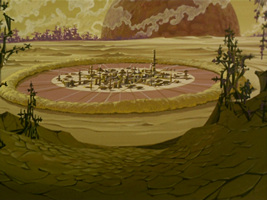
 ShirKahr in TAS: "Yesteryear"
ShirKahr in TAS: "Yesteryear"